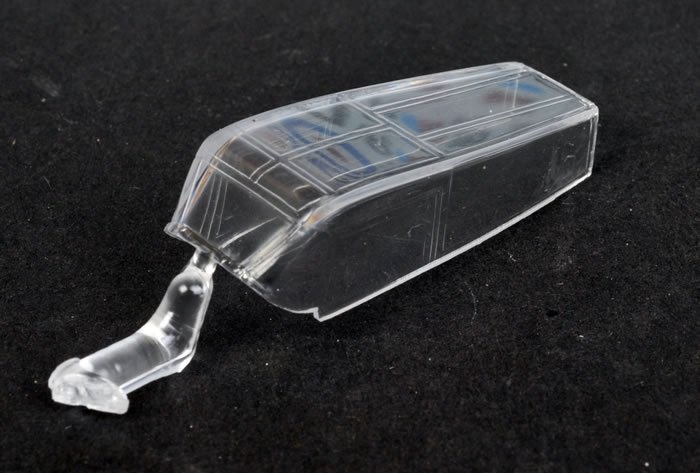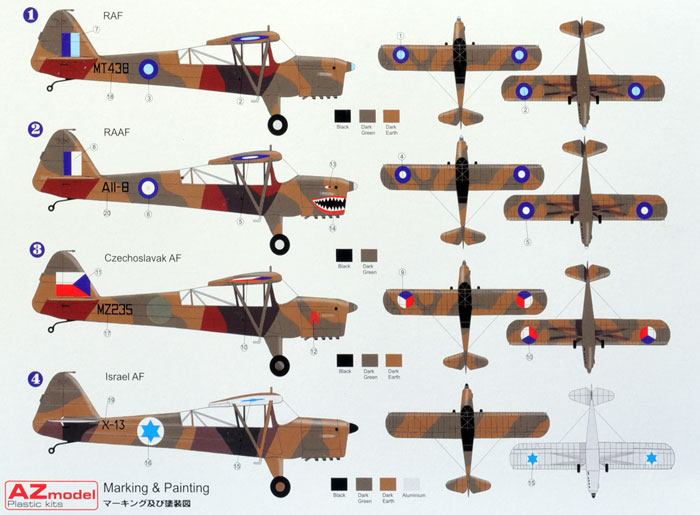Auster A.O.P. Mk III

AZ Model, 1/72 scale
S u m m a r y : |
Catalogue Number: |
AZ Model kit No. AZ 7263 Auster A.O.P. Mk. III |
Scale: |
1/72 |
Contents & Media |
39 mid grey plastic parts on one sprue, 1 clear injection moulded canopy, 1 resin part (exhausts), decals for 4 aircraft plus a 4 page A5 sized instruction sheet with history, parts plan, 10 build diagrams and a stencil placement guide. Paint and decal instructions are on the box back. |
Price: |
Available on-line from Hannants for £11.74 and Modelimex for €12.61 |
Review Type: |
First Look |
Advantages: |
The first 1/72 scale Auster since Airfix's example of many years ago; good detail inside and out; injected canopy and excellent decals. |
Disadvantages: |
Instructions are a bit vague in places; interior frame work is a bit overscale and the resin exhaust is missing the four stubs. |
Conclusions: |
The above faults are either fixable or you're just going to have to live with them but even so, I think it will prove superior to Airfix's although I wish AZ had included the seaplane version as well. |
Reviewed by Glen Porter

HyperScale is proudly supported by Squadron.com
The Taylorcraft Auster was a British version of the American Taylorcraft aircraft. The Auster A.O.P. Mk. III had a de Havilland Gipsy Major engine of 130 hp (97 kW) and was design for the British Army as an Artillery Air Observation Post aircraft.
On opening the European style end-opening box, there is one sprue in mid-grey plastic that carries all the plastic parts except for the canopy and resin exhaust. The mould detail looks quite good with no noticeable ejector pin marks, a small amount of flash but prominent mould seam lines so every part will require some cleanup. Of course, this is a short-run kit so care will need to be taken, especially mounting the wings to the clear canopy, as there are no alignment pins at all.
There is extensive framing for the cockpit interior but unfortunately it is somewhat over scale. I initially thought some of it could be replaced with smaller plastic rod but it is just too complex, perhaps scraping the mould seams may help.
The clear canopy is well moulded with good frame detail and shouldn't be a problem providing you can figure out how to handle those wing to canopy joints.

A small resin insert is provided for the exhausts which fits under the engine cowling but the four extended pipes are missing from it. Just why they did it in resin is a mystery as I'm sure they could have done it in plastic but none the less, it should not be hard to fix with a small drill and plastic rod.
To my mind, the instructions let this model down the most. In build diagram number 2, which shows the instrument panel and its cowl, there is a small piece of rod with some kind of ball on one end to be scratch built, about 4mm long and painted red brown. I have no idea what it is or how it is attached and it is shown no-where else in the instructions.
In diagram 4, the wrong location for the side framing to be attached to the roof is shown. Fortunately, number 6 shows the correct location but then another small bit of framing which locates into the front of the canopy but no indication of where it attaches to the fuselage.
This whole area of the instructions is too vague and will need careful study to get a reasonable outcome.
Decals look very good with spot-on register, colour density and minimum carrier film. There are markings for four aircraft, MT 438, an RAF aircraft with SEAT markings in the usual places. A11-8 is an RAAF example with blue and white roundels and fin flash plus a shark mouth and eye on the nose. Next is MZ 235, an ex-RAF aircraft flown by the Czechoslovak Air Force with Czech roundels on the wings but no fuselage marking except for a red griffin on the nose. Last but not least, an Israeli aircraft, X-13 with the usual Israeli markings in six places.

Apart from the last example, which has aluminium undersides, the rest are shown in a wraparound RAF Dark Green and Dark Earth camouflage pattern that I' have never seen before. I can't speak for the other three, but the RAAF scheme is definitely wrong. Although shown in the green and brown, the colour recommendation just says dark green.

In fact these Austers were flown in overall Foliage Green, normally quoted as FS 34092. Also, the fuselage roundel should not have a red dot in it as shown in the instructions and on the decal sheet.
Okay, so it's not a 'Shake and Bake' kit and therefore not for beginners, but if those instructions are studied carefully I think a reasonably detailed and accurate model can be had. I just wish AZ would take a bit more care with their instructions and colour schemes.
Thanks to Legato / AZ Models for the sample
Review Text Copyright © 2009 by Mark Davies
Page Created 22 July, 2009
Last updated
22 July, 2009
Back to HyperScale Main Page
Back to Reviews Page

|
Home
| What's New |
Features |
Gallery |
Reviews |
Reference |
Forum |
Search